Health and Social Care Report: Assistive Technology and Service Users
VerifiedAdded on 2020/06/06
|7
|1387
|35
Report
AI Summary
This report examines the application and impact of assistive technology within the health and social care sector. It begins by highlighting how assistive technologies promote independence and enhance the lives of service users with diverse needs, such as those with visual impairments, mobility issues, and memory loss. The report delves into the barriers that can hinder the effective use of these technologies, including cost, training requirements, and technical issues. It then explores the health and safety considerations associated with assistive devices, emphasizing the importance of safety standards and regular maintenance. The report also discusses the influence of technological advancements on healthcare professionals and the industry, detailing how these innovations improve diagnosis and patient care. The report uses case studies to illustrate the practical application of assistive technologies, like medication dispensers and monitoring devices, to improve patient outcomes and support independent living. The conclusion underscores the critical role of technology in empowering service users and improving the overall quality of care within the health and social care landscape.
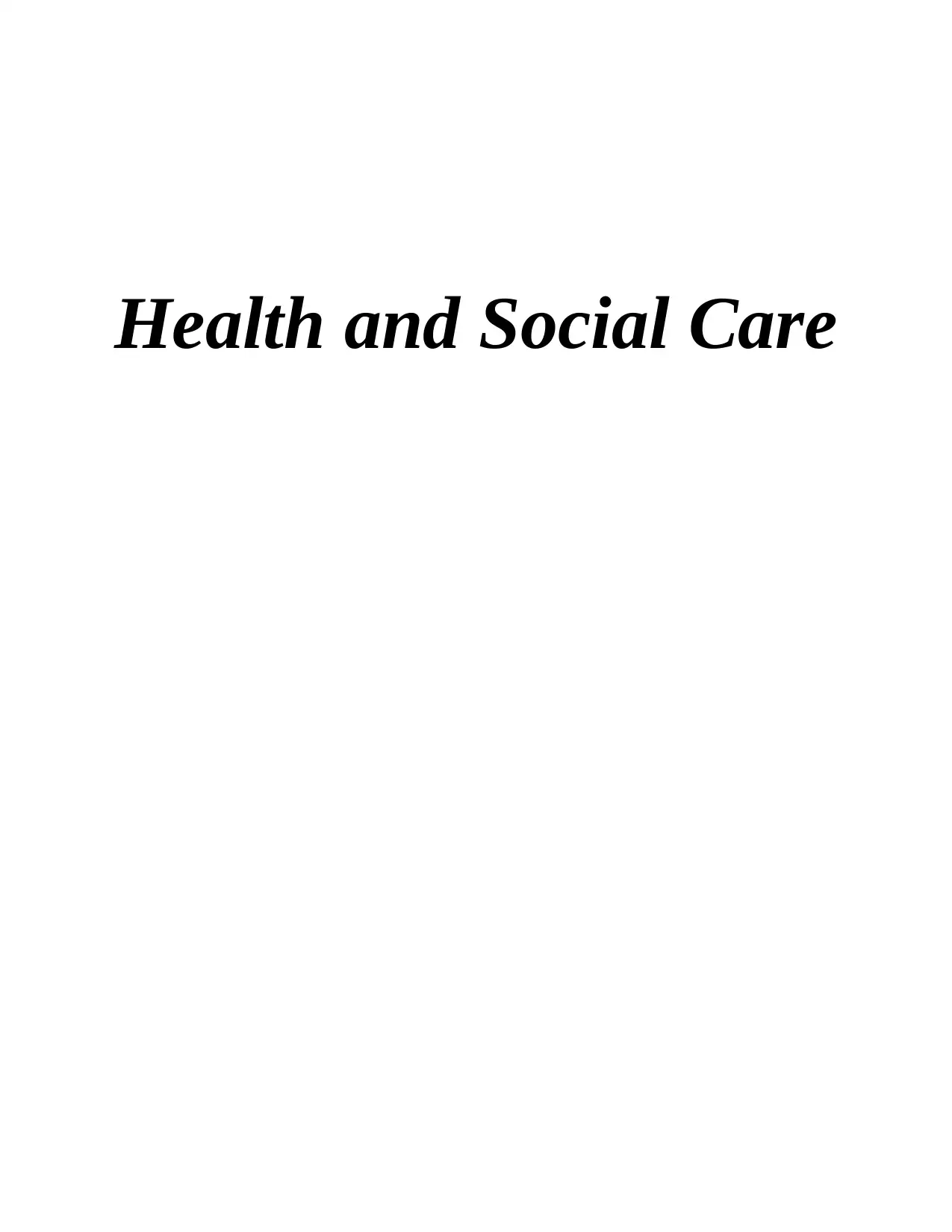
Health and Social Care
Paraphrase This Document
Need a fresh take? Get an instant paraphrase of this document with our AI Paraphraser

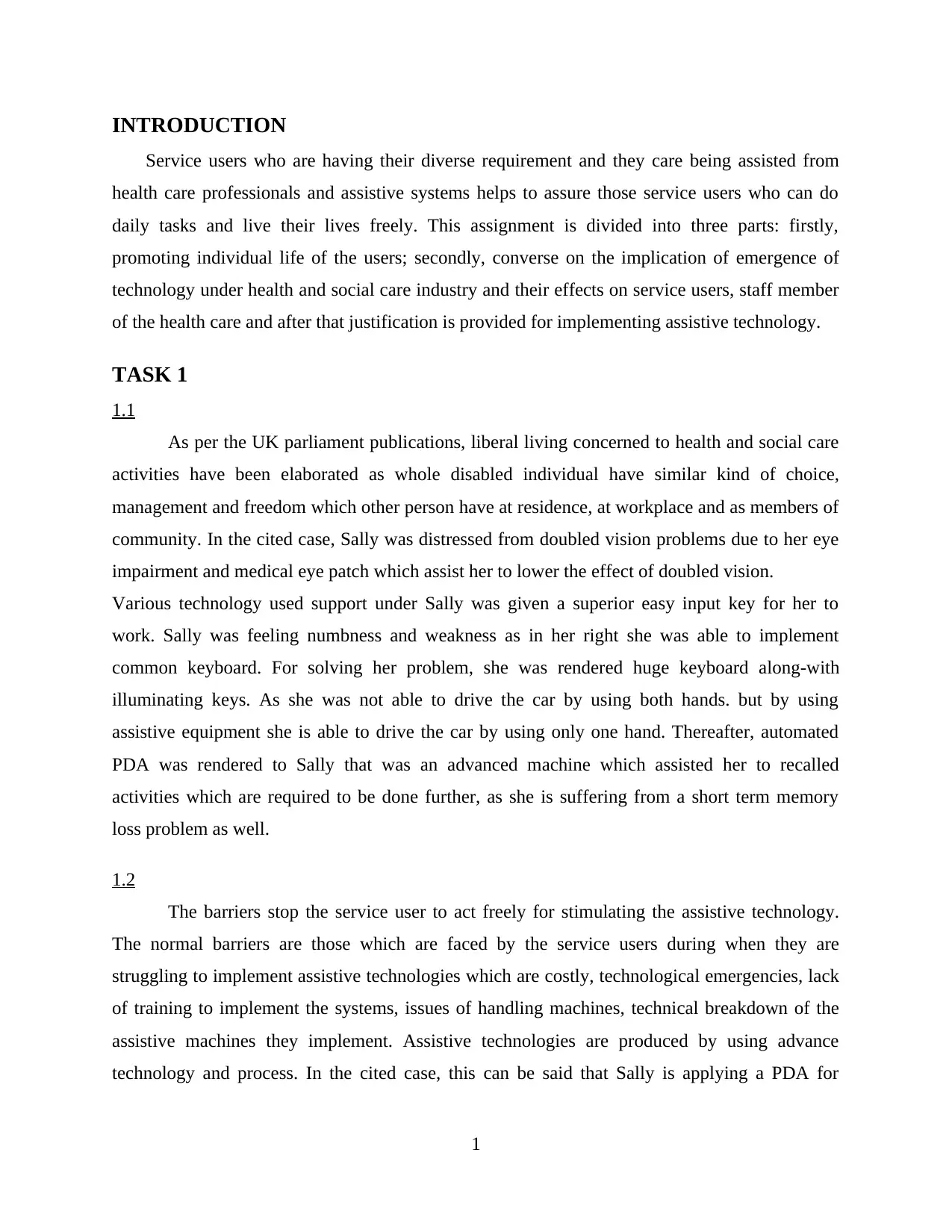
INTRODUCTION
Service users who are having their diverse requirement and they care being assisted from
health care professionals and assistive systems helps to assure those service users who can do
daily tasks and live their lives freely. This assignment is divided into three parts: firstly,
promoting individual life of the users; secondly, converse on the implication of emergence of
technology under health and social care industry and their effects on service users, staff member
of the health care and after that justification is provided for implementing assistive technology.
TASK 1
1.1
As per the UK parliament publications, liberal living concerned to health and social care
activities have been elaborated as whole disabled individual have similar kind of choice,
management and freedom which other person have at residence, at workplace and as members of
community. In the cited case, Sally was distressed from doubled vision problems due to her eye
impairment and medical eye patch which assist her to lower the effect of doubled vision.
Various technology used support under Sally was given a superior easy input key for her to
work. Sally was feeling numbness and weakness as in her right she was able to implement
common keyboard. For solving her problem, she was rendered huge keyboard along-with
illuminating keys. As she was not able to drive the car by using both hands. but by using
assistive equipment she is able to drive the car by using only one hand. Thereafter, automated
PDA was rendered to Sally that was an advanced machine which assisted her to recalled
activities which are required to be done further, as she is suffering from a short term memory
loss problem as well.
1.2
The barriers stop the service user to act freely for stimulating the assistive technology.
The normal barriers are those which are faced by the service users during when they are
struggling to implement assistive technologies which are costly, technological emergencies, lack
of training to implement the systems, issues of handling machines, technical breakdown of the
assistive machines they implement. Assistive technologies are produced by using advance
technology and process. In the cited case, this can be said that Sally is applying a PDA for
1
Service users who are having their diverse requirement and they care being assisted from
health care professionals and assistive systems helps to assure those service users who can do
daily tasks and live their lives freely. This assignment is divided into three parts: firstly,
promoting individual life of the users; secondly, converse on the implication of emergence of
technology under health and social care industry and their effects on service users, staff member
of the health care and after that justification is provided for implementing assistive technology.
TASK 1
1.1
As per the UK parliament publications, liberal living concerned to health and social care
activities have been elaborated as whole disabled individual have similar kind of choice,
management and freedom which other person have at residence, at workplace and as members of
community. In the cited case, Sally was distressed from doubled vision problems due to her eye
impairment and medical eye patch which assist her to lower the effect of doubled vision.
Various technology used support under Sally was given a superior easy input key for her to
work. Sally was feeling numbness and weakness as in her right she was able to implement
common keyboard. For solving her problem, she was rendered huge keyboard along-with
illuminating keys. As she was not able to drive the car by using both hands. but by using
assistive equipment she is able to drive the car by using only one hand. Thereafter, automated
PDA was rendered to Sally that was an advanced machine which assisted her to recalled
activities which are required to be done further, as she is suffering from a short term memory
loss problem as well.
1.2
The barriers stop the service user to act freely for stimulating the assistive technology.
The normal barriers are those which are faced by the service users during when they are
struggling to implement assistive technologies which are costly, technological emergencies, lack
of training to implement the systems, issues of handling machines, technical breakdown of the
assistive machines they implement. Assistive technologies are produced by using advance
technology and process. In the cited case, this can be said that Sally is applying a PDA for
1
⊘ This is a preview!⊘
Do you want full access?
Subscribe today to unlock all pages.

Trusted by 1+ million students worldwide
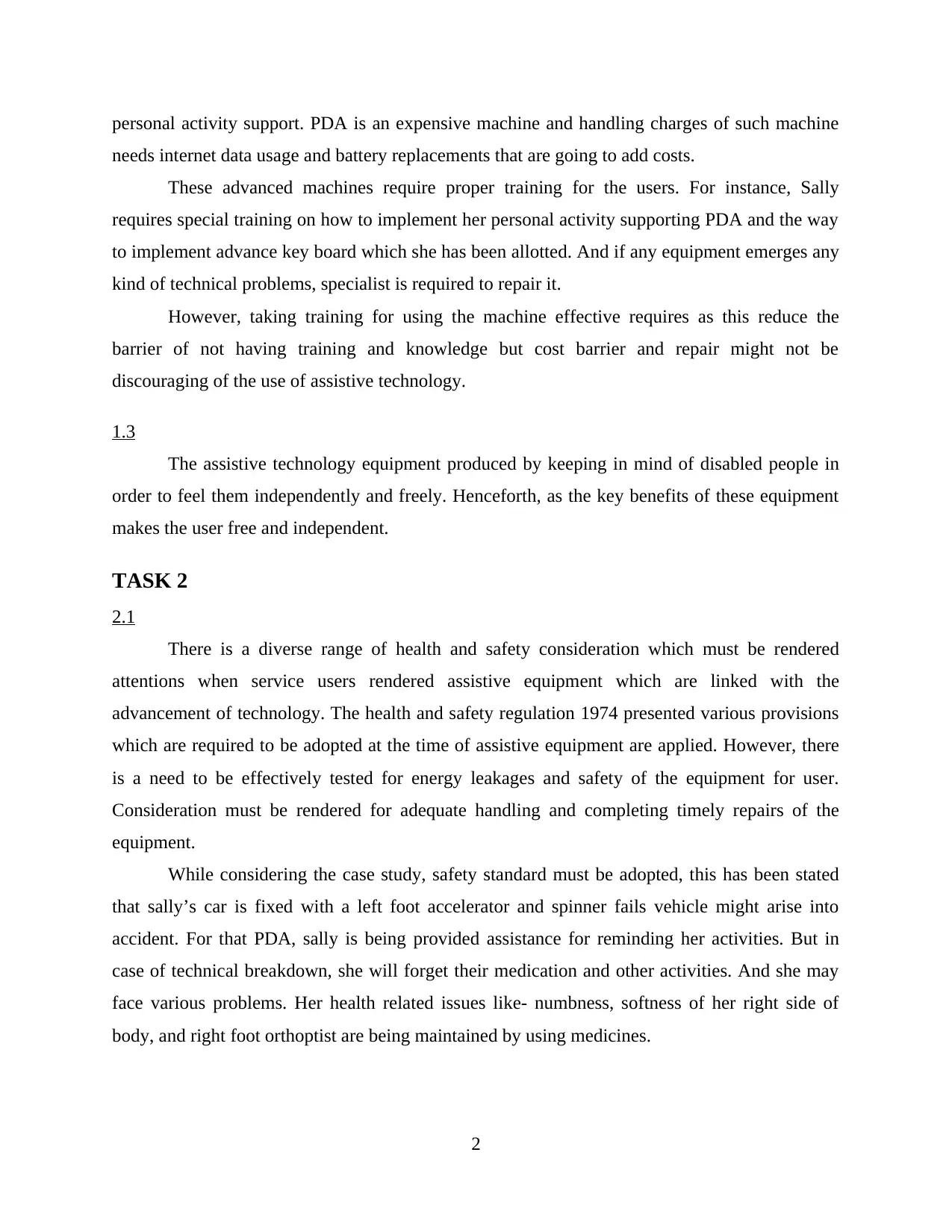
personal activity support. PDA is an expensive machine and handling charges of such machine
needs internet data usage and battery replacements that are going to add costs.
These advanced machines require proper training for the users. For instance, Sally
requires special training on how to implement her personal activity supporting PDA and the way
to implement advance key board which she has been allotted. And if any equipment emerges any
kind of technical problems, specialist is required to repair it.
However, taking training for using the machine effective requires as this reduce the
barrier of not having training and knowledge but cost barrier and repair might not be
discouraging of the use of assistive technology.
1.3
The assistive technology equipment produced by keeping in mind of disabled people in
order to feel them independently and freely. Henceforth, as the key benefits of these equipment
makes the user free and independent.
TASK 2
2.1
There is a diverse range of health and safety consideration which must be rendered
attentions when service users rendered assistive equipment which are linked with the
advancement of technology. The health and safety regulation 1974 presented various provisions
which are required to be adopted at the time of assistive equipment are applied. However, there
is a need to be effectively tested for energy leakages and safety of the equipment for user.
Consideration must be rendered for adequate handling and completing timely repairs of the
equipment.
While considering the case study, safety standard must be adopted, this has been stated
that sally’s car is fixed with a left foot accelerator and spinner fails vehicle might arise into
accident. For that PDA, sally is being provided assistance for reminding her activities. But in
case of technical breakdown, she will forget their medication and other activities. And she may
face various problems. Her health related issues like- numbness, softness of her right side of
body, and right foot orthoptist are being maintained by using medicines.
2
needs internet data usage and battery replacements that are going to add costs.
These advanced machines require proper training for the users. For instance, Sally
requires special training on how to implement her personal activity supporting PDA and the way
to implement advance key board which she has been allotted. And if any equipment emerges any
kind of technical problems, specialist is required to repair it.
However, taking training for using the machine effective requires as this reduce the
barrier of not having training and knowledge but cost barrier and repair might not be
discouraging of the use of assistive technology.
1.3
The assistive technology equipment produced by keeping in mind of disabled people in
order to feel them independently and freely. Henceforth, as the key benefits of these equipment
makes the user free and independent.
TASK 2
2.1
There is a diverse range of health and safety consideration which must be rendered
attentions when service users rendered assistive equipment which are linked with the
advancement of technology. The health and safety regulation 1974 presented various provisions
which are required to be adopted at the time of assistive equipment are applied. However, there
is a need to be effectively tested for energy leakages and safety of the equipment for user.
Consideration must be rendered for adequate handling and completing timely repairs of the
equipment.
While considering the case study, safety standard must be adopted, this has been stated
that sally’s car is fixed with a left foot accelerator and spinner fails vehicle might arise into
accident. For that PDA, sally is being provided assistance for reminding her activities. But in
case of technical breakdown, she will forget their medication and other activities. And she may
face various problems. Her health related issues like- numbness, softness of her right side of
body, and right foot orthoptist are being maintained by using medicines.
2
Paraphrase This Document
Need a fresh take? Get an instant paraphrase of this document with our AI Paraphraser
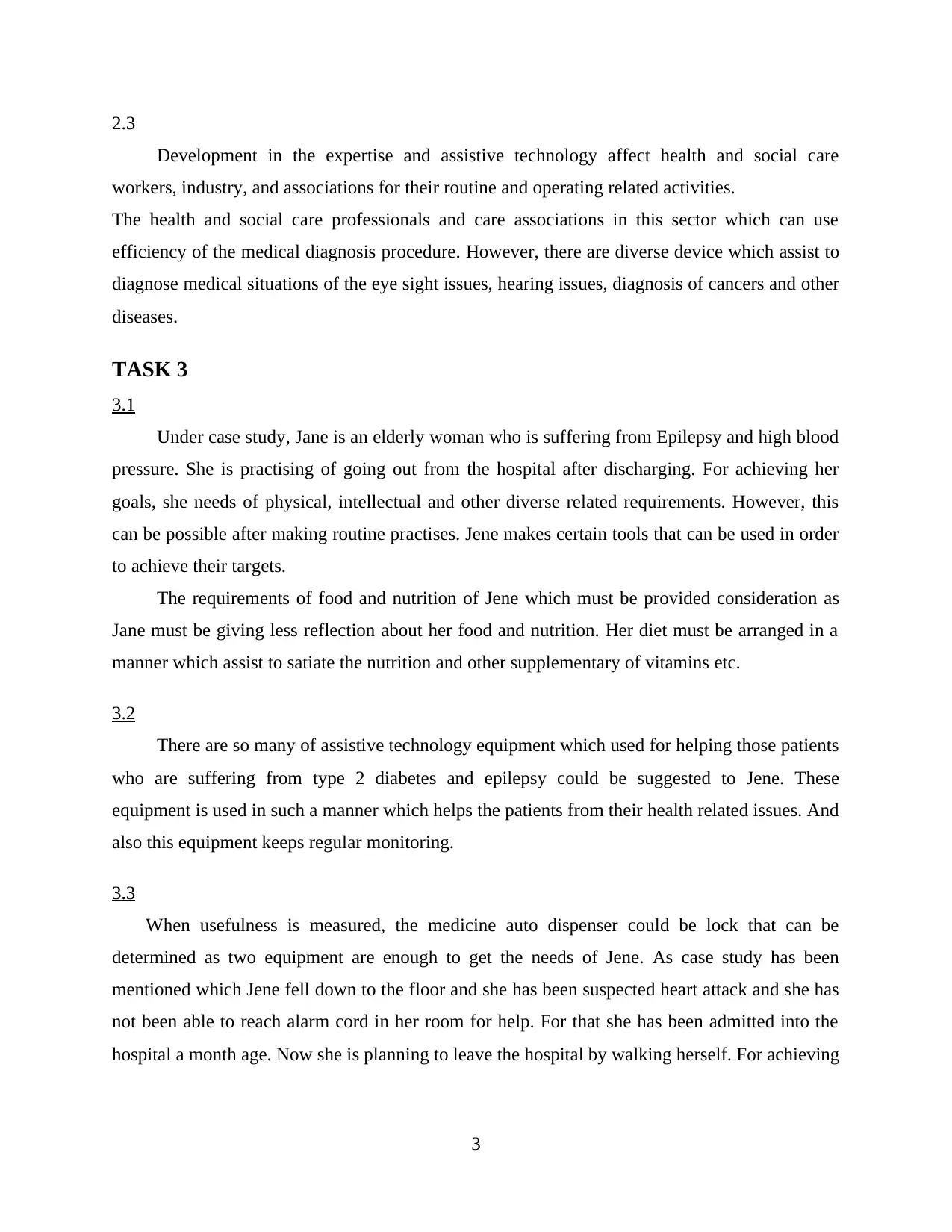
2.3
Development in the expertise and assistive technology affect health and social care
workers, industry, and associations for their routine and operating related activities.
The health and social care professionals and care associations in this sector which can use
efficiency of the medical diagnosis procedure. However, there are diverse device which assist to
diagnose medical situations of the eye sight issues, hearing issues, diagnosis of cancers and other
diseases.
TASK 3
3.1
Under case study, Jane is an elderly woman who is suffering from Epilepsy and high blood
pressure. She is practising of going out from the hospital after discharging. For achieving her
goals, she needs of physical, intellectual and other diverse related requirements. However, this
can be possible after making routine practises. Jene makes certain tools that can be used in order
to achieve their targets.
The requirements of food and nutrition of Jene which must be provided consideration as
Jane must be giving less reflection about her food and nutrition. Her diet must be arranged in a
manner which assist to satiate the nutrition and other supplementary of vitamins etc.
3.2
There are so many of assistive technology equipment which used for helping those patients
who are suffering from type 2 diabetes and epilepsy could be suggested to Jene. These
equipment is used in such a manner which helps the patients from their health related issues. And
also this equipment keeps regular monitoring.
3.3
When usefulness is measured, the medicine auto dispenser could be lock that can be
determined as two equipment are enough to get the needs of Jene. As case study has been
mentioned which Jene fell down to the floor and she has been suspected heart attack and she has
not been able to reach alarm cord in her room for help. For that she has been admitted into the
hospital a month age. Now she is planning to leave the hospital by walking herself. For achieving
3
Development in the expertise and assistive technology affect health and social care
workers, industry, and associations for their routine and operating related activities.
The health and social care professionals and care associations in this sector which can use
efficiency of the medical diagnosis procedure. However, there are diverse device which assist to
diagnose medical situations of the eye sight issues, hearing issues, diagnosis of cancers and other
diseases.
TASK 3
3.1
Under case study, Jane is an elderly woman who is suffering from Epilepsy and high blood
pressure. She is practising of going out from the hospital after discharging. For achieving her
goals, she needs of physical, intellectual and other diverse related requirements. However, this
can be possible after making routine practises. Jene makes certain tools that can be used in order
to achieve their targets.
The requirements of food and nutrition of Jene which must be provided consideration as
Jane must be giving less reflection about her food and nutrition. Her diet must be arranged in a
manner which assist to satiate the nutrition and other supplementary of vitamins etc.
3.2
There are so many of assistive technology equipment which used for helping those patients
who are suffering from type 2 diabetes and epilepsy could be suggested to Jene. These
equipment is used in such a manner which helps the patients from their health related issues. And
also this equipment keeps regular monitoring.
3.3
When usefulness is measured, the medicine auto dispenser could be lock that can be
determined as two equipment are enough to get the needs of Jene. As case study has been
mentioned which Jene fell down to the floor and she has been suspected heart attack and she has
not been able to reach alarm cord in her room for help. For that she has been admitted into the
hospital a month age. Now she is planning to leave the hospital by walking herself. For achieving
3
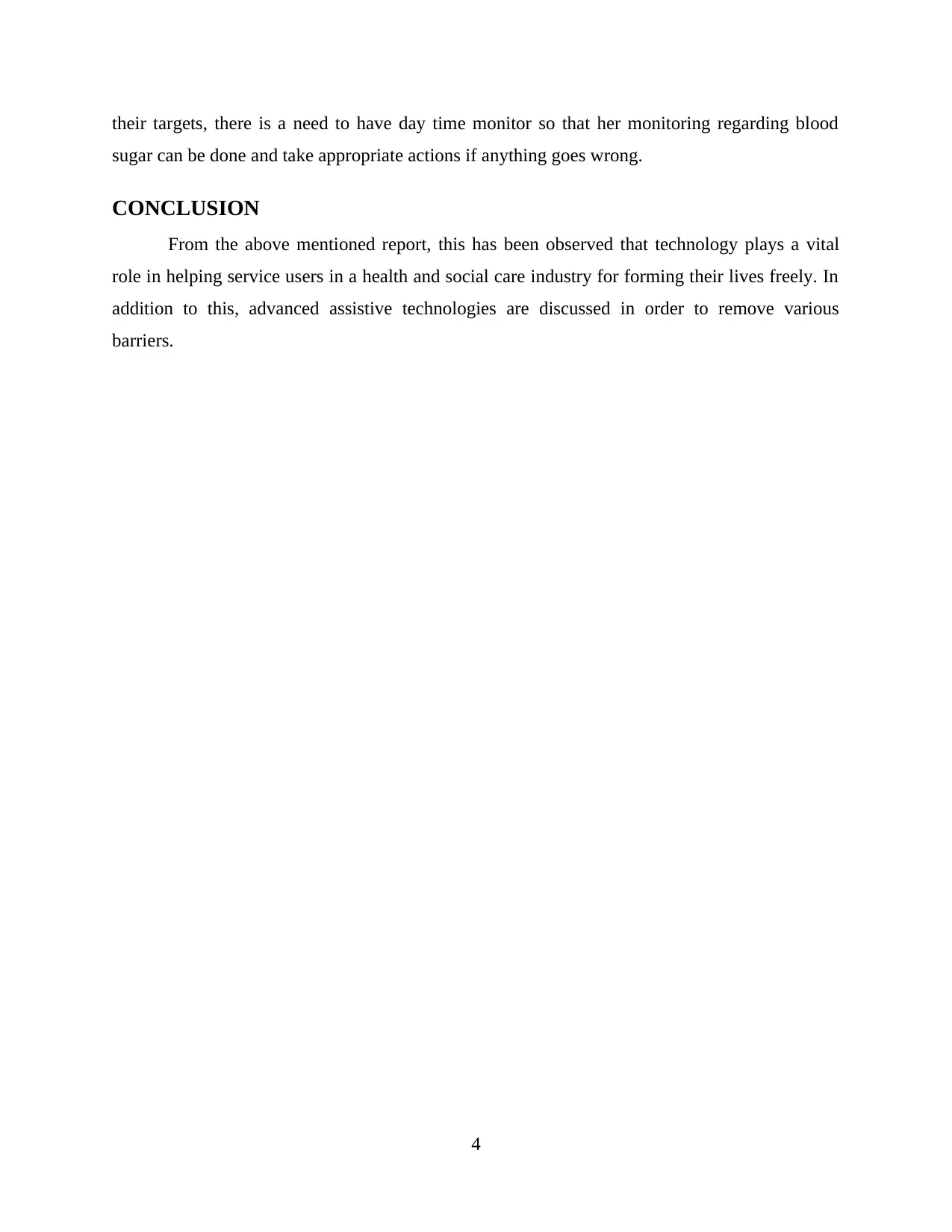
their targets, there is a need to have day time monitor so that her monitoring regarding blood
sugar can be done and take appropriate actions if anything goes wrong.
CONCLUSION
From the above mentioned report, this has been observed that technology plays a vital
role in helping service users in a health and social care industry for forming their lives freely. In
addition to this, advanced assistive technologies are discussed in order to remove various
barriers.
4
sugar can be done and take appropriate actions if anything goes wrong.
CONCLUSION
From the above mentioned report, this has been observed that technology plays a vital
role in helping service users in a health and social care industry for forming their lives freely. In
addition to this, advanced assistive technologies are discussed in order to remove various
barriers.
4
⊘ This is a preview!⊘
Do you want full access?
Subscribe today to unlock all pages.

Trusted by 1+ million students worldwide
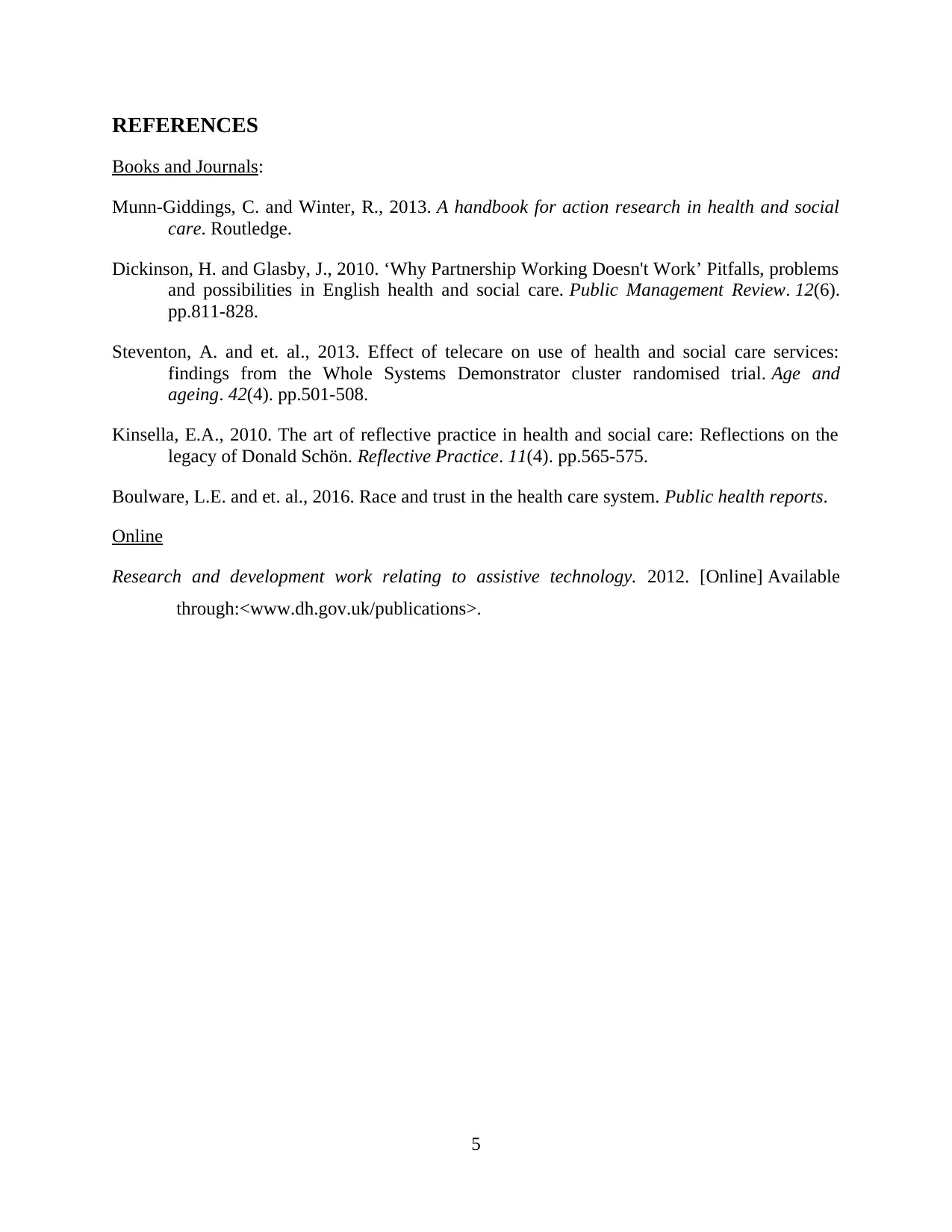
REFERENCES
Books and Journals:
Munn-Giddings, C. and Winter, R., 2013. A handbook for action research in health and social
care. Routledge.
Dickinson, H. and Glasby, J., 2010. ‘Why Partnership Working Doesn't Work’ Pitfalls, problems
and possibilities in English health and social care. Public Management Review. 12(6).
pp.811-828.
Steventon, A. and et. al., 2013. Effect of telecare on use of health and social care services:
findings from the Whole Systems Demonstrator cluster randomised trial. Age and
ageing. 42(4). pp.501-508.
Kinsella, E.A., 2010. The art of reflective practice in health and social care: Reflections on the
legacy of Donald Schön. Reflective Practice. 11(4). pp.565-575.
Boulware, L.E. and et. al., 2016. Race and trust in the health care system. Public health reports.
Online
Research and development work relating to assistive technology. 2012. [Online] Available
through:<www.dh.gov.uk/publications>.
5
Books and Journals:
Munn-Giddings, C. and Winter, R., 2013. A handbook for action research in health and social
care. Routledge.
Dickinson, H. and Glasby, J., 2010. ‘Why Partnership Working Doesn't Work’ Pitfalls, problems
and possibilities in English health and social care. Public Management Review. 12(6).
pp.811-828.
Steventon, A. and et. al., 2013. Effect of telecare on use of health and social care services:
findings from the Whole Systems Demonstrator cluster randomised trial. Age and
ageing. 42(4). pp.501-508.
Kinsella, E.A., 2010. The art of reflective practice in health and social care: Reflections on the
legacy of Donald Schön. Reflective Practice. 11(4). pp.565-575.
Boulware, L.E. and et. al., 2016. Race and trust in the health care system. Public health reports.
Online
Research and development work relating to assistive technology. 2012. [Online] Available
through:<www.dh.gov.uk/publications>.
5
1 out of 7
Related Documents
Your All-in-One AI-Powered Toolkit for Academic Success.
+13062052269
info@desklib.com
Available 24*7 on WhatsApp / Email
![[object Object]](/_next/static/media/star-bottom.7253800d.svg)
Unlock your academic potential
Copyright © 2020–2025 A2Z Services. All Rights Reserved. Developed and managed by ZUCOL.




